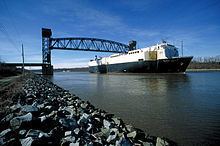Maintained by Norfolk Southern Opened 1966 | Design Vertical-lift bridge Bridge type Vertical-lift bridge | |
 | ||
Carries 1 Norfolk Southern rail line Body of water Chesapeake & Delaware Canal Similar Chesapeake & Delaware, Summit Bridge, Chesapeake City Bridge, St Georges Bridge, Fourteenth Street Bridge | ||
The Chesapeake & Delaware Canal Lift Bridge is a railroad bridge with vertical-lift span in the U.S. state of Delaware. It carries a Norfolk Southern rail line across the Chesapeake & Delaware Canal.
This bridge was built by the U.S. Army Corps of Engineers as part of a canal expansion project and opened in 1966. The Canal Lift Bridge, the only drawbridge on the C & D Canal (other lift bridges, carrying vehicular traffic, had since been replaced with high-level crossings) was owned and operated by the Pennsylvania Railroad, Penn Central, and Conrail before Norfolk Southern acquired ownership of it in 1998. The bridge is used primarily by NS on its Delmarva Secondary (which connects the Eastern Shore of both Maryland and Virginia with the Shellpot Branch (a former electrified thru-freight line) and the Port of Wilmington. It has also been used by Amtrak for special NASCAR and Delaware State Fair events held throughout the year, with the trains departing from 30th Street Station in Philadelphia and using Amtrak's Northeast Corridor to the Bell Junction near Edgemoor, then departing a short distance later on the Shellpot Branch and later the Delmarva Branch.
The bridge carries a single track across the canal and is kept open to allow the free flow of shipping traffic underneath. If a freight train plans on crossing the canal in either direction, the engineer must contact the bridge operator at least 30 minutes before crossing, as to allow the bridge to be lowered. Most canal crossings occur at night when most of the shipping traffic (along with Amtrak and SEPTA train traffic farther north) is at a minimum. The northern approach to the Canal Lift Bridge bisects an abandoned section of the C & D Canal, which was bypassed in the 1960s with the current sea-level channel.
